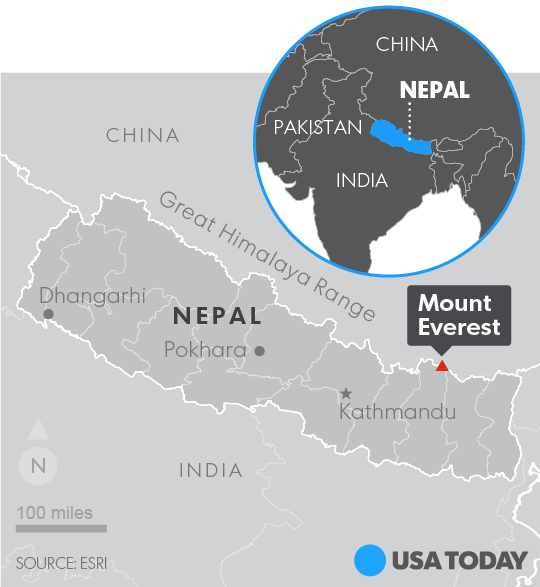Mount Everest claims three lives in three days

Mount Everest's "death zone" claimed three lives in three days over the weekend while two other climbers remained missing Monday on the crowded, treacherous mountain.
The tragedies heightened concerns once again about the dangers of climbing the world's tallest mountain, a behemoth reaching more than 29,000 feet into the Asian sky on the border of Nepal and Tibet.
Relatively good conditions so far this year have brought large numbers of summit hopefuls to the mountain the Nepalese call Sagarmāthā, which loosely translates to "forehead in the sky." Scores of climbers have managed to reach the summit in the past few days.
Among them was the first combat amputee to climb the mountain, Marine Corps veteran Thomas Charles "Charlie" Linville, 30, who lost his leg to an IED in Iraq in 2011. Another combat amputee, former Army reservist Chad Jukes, 32, is attempting to follow Linville to the top.
Good conditions, however, draw crowds. That can mean climbers lined up at dangerous altitudes, waiting their turn to reach the summit. Dan Richards runs Global Rescue, which has evacuated a dozen or more climbers from Everest since the 2016 season began last month.
"What you are seeing this year is pent-up demand," Richards told USA TODAY. "Everest has become very much a commercial enterprise, but it's not like every climbing group is coordinating with every other group. You can end up with congestion. There is traffic on Everest."
Indian climber Subhash Paul died Sunday while being helped down the mountain by Sherpa guides one day after reaching the summit. Two other Indian climbers lost contact with their group and disappeared Saturday on slopes in the “death zone" — an area starting at about 26,000 feet, where the air is too thin to sustain life. Hopes for their survival were fading.
Late Friday, Eric Arnold, 35, a Dutchman from Rotterdam, had reached the summit on his fifth attempt just hours before his death. Early Saturday, Australian climber Maria Strydom, 34, who was trekking with her husband, also died while descending the mountain.
The recurring theme was altitude sickness. Reaching the top, while exhilarating, is not enough. The climb down can be treacherous as exhausted climbers race the clock and sometimes weather on icy, treacherous routes.
Deaths, rescue mark perilous weekend on Mount Everest
"Many climbers without any experience crowd Everest every year, and companies often use poor quality equipment... offering cheap packages to clients who are exposed to security risks," Nepal Mountaineering Association Chief Ang Tshering Sherpa told Reuters.
Massive tragedies in recent years have put an economic crunch on the climbing industry. At least 18 people died last year when an earthquake sent a massive snow slide roaring through Base Camp, abruptly ending the climbing season. In 2014, an avalanche killed 16 guides and cut the season short.
"The last two disasters on Everest were caused by nature, but not this one," Ang Tshering told AP.
Nepal Mountaineering Department official Gyanendra Shrestha told The Himalayan Times that about 30 climbers have developed frostbite or become sick near the summit in recent days. She said good weather has allowed almost 400 climbers to reach the summit from Nepal since May 11 but added that the altitude, weather and harsh terrain can cause problems at any time. The season generally ends in early June.
"There is a short weather window to actually summit, and people are pushing it," Richards said.
